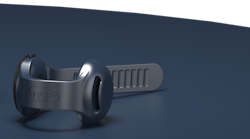Noninvasive techniques such as arm sensors have simplified how people with diabetes monitor and measure their blood glucose levels. Now, researchers are working to make the process even easier (see video).
Medical device company RSP Systems (Odense, Denmark) has joined forces with TRUMPF Photonic Components (Ulm, Germany) to create a miniaturized, wearable sensor that reads blood glucose levels quickly and noninvasively—meaning no blood samples are required—using miniature laser diodes (vertical-cavity surface-emitting lasers [VCSELs]).
The new sensor, which looks like a wristwatch, uses Raman spectroscopy (see figure). It features a laser/probe assembly on the underside clasp and works by sending light into the skin at the point of that clasp on the wrist at a controlled depth—laser light is shined at the molecules, including glucose. The sensor receives the Raman scattered light (elastically scattered light) that stems from the interstitial fluid, which is found in the space that surrounds cells. It contains information about glucose and measures the frequency change of that returning light. The light is wavelength-decomposed by a microspectrometer; the spectra is processed using proprietary mathematical models built on extensive calibration data.
“Our device will measure the single most important analyte (blood glucose) without piercing the skin and without being obtrusive,” says Anders Weber, CEO of RSP Systems. Essentially, it’s a scaled-down version of the company’s already-established glucose sensor that’s about the size of a paperback book.
This is a huge advantage over traditional “finger-prick” methods and newer systems, too, which do still require some level of invasiveness. While blood glucose monitoring is crucial for those with diabetes, Weber says, the invasiveness and lack of discretion of current options can be a deterrent to diligence.
“Diabetes and its complications are a huge societal liability, slated to claim as much as a quarter of all health-related costs as the obesity epidemic continues to spread,” Weber says.
He adds that the advantages of the new RSP-TRUMPF system include not only enhancing the lives of people in need of daily blood glucose measurements “more tolerable to the improvement of compliance,” it could also help healthcare professionals better identify those at risk for diabetes.
“This may, in time, inform legislators to take measures to cope with challenges—for example, lifestyle changes and incentivizing them,” Weber says. “Proper understanding of glucose levels in people is by far the most potent factor in containing health-related costs for individuals as well as society.”
The joint research team says they’re working on “several ancillary components to complete the wearable sensor package.” Once that is complete, they will perform clinical evaluations and testing, and look toward system integration.
“We want to disrupt the current market for glucose measurement for diabetes management,” Weber says. “And we want to promote the more widespread use of glucose testing for the benefit of the type 2 diabetes population.”

Justine Murphy | Multimedia Director, Digital Infrastructure
Justine Murphy is the multimedia director for Endeavor Business Media's Digital Infrastructure Group. She is a multiple award-winning writer and editor with more 20 years of experience in newspaper publishing as well as public relations, marketing, and communications. For nearly 10 years, she has covered all facets of the optics and photonics industry as an editor, writer, web news anchor, and podcast host for an internationally reaching magazine publishing company. Her work has earned accolades from the New England Press Association as well as the SIIA/Jesse H. Neal Awards. She received a B.A. from the Massachusetts College of Liberal Arts.
